
Are you interested in making the most of your small space? Creating a squash container garden is a fantastic solution! With the right squash varieties and smart container choices, you can grow beautiful, lively plants while enjoying tasty produce right at your home.
By learning how to use your space effectively, you can transform even the tiniest area into a flourishing garden. Just think about the delicious squash dishes you could prepare! So, let’s dive into some helpful tips and tricks to set up your own squash container garden.
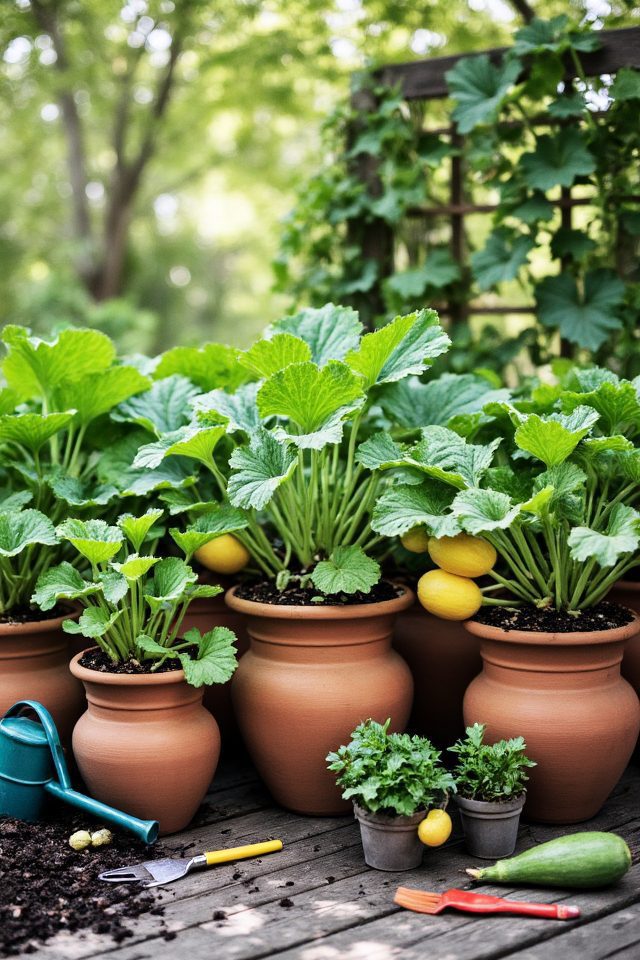
When choosing the right containers for growing squash, opt for large, sturdy pots with a minimum depth of 12-18 inches to accommodate the plant’s extensive root system.
Make sure they’ve drainage holes to prevent waterlogging. Materials like clay, plastic, or wood work well, but consider lightweight options if mobility is a concern.
Additionally, select containers that offer ample space for sprawling varieties, allowing for healthy growth and abundant yields.
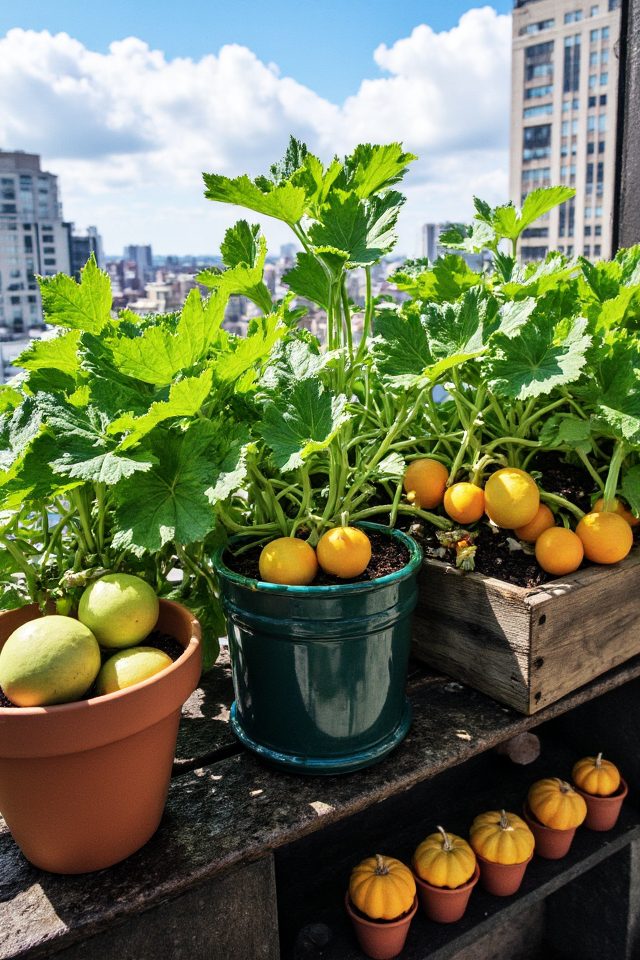
When it comes to container gardening, selecting the right squash varieties is essential for success. Some of the best options include bush types like ‘Patty Pan’, ‘Butterstick’, and ‘Baby Bear’.
These smaller, more compact varieties thrive in limited spaces and produce plentiful yields. Additionally, zucchini hybrids such as ‘Black Beauty’ are perfect for containers due to their manageable size and prolific fruiting.
Make sure your containers are large enough, ideally 5-10 gallons, to provide ample space for root development.
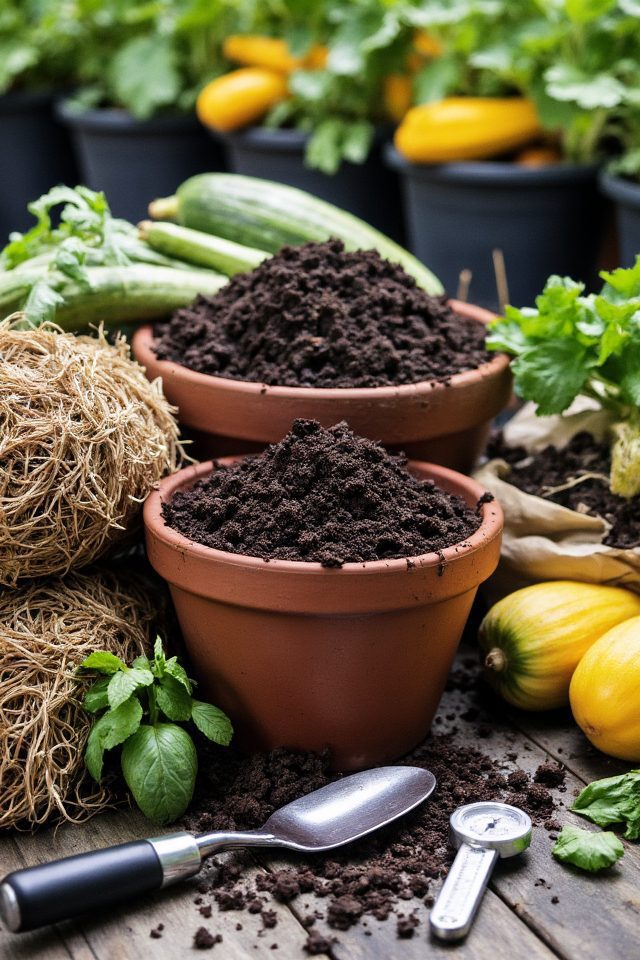
Soil preparation is essential for a thriving squash container garden. Start with a high-quality potting mix designed for vegetables, ensuring it retains moisture while providing good drainage.
Incorporate organic matter, such as compost or well-rotted manure, to enrich the soil with nutrients.
Adjust the pH to around 6.0 to 6.8, as squash prefers slightly acidic to neutral soil.
Regularly aerate the soil and check for pests to foster healthy growth and abundant yields.
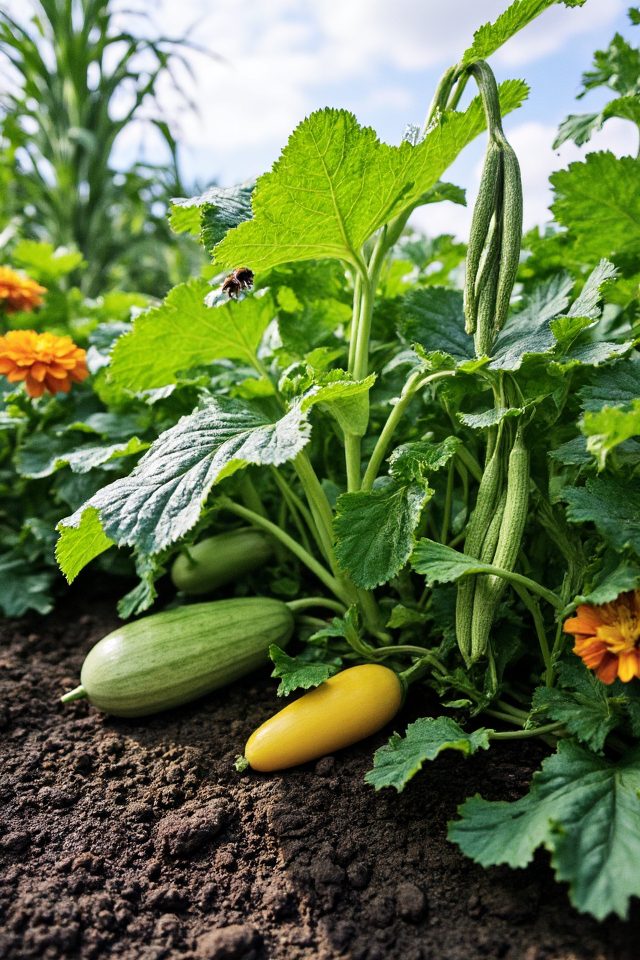
Companion planting with squash involves pairing these vibrant plants with compatible crops to enhance growth, deter pests, and maximize yields.
Ideal companions include beans, which fix nitrogen in the soil, and corn, which provides natural support.
Utilizing flowers like marigolds can help repel harmful insects.
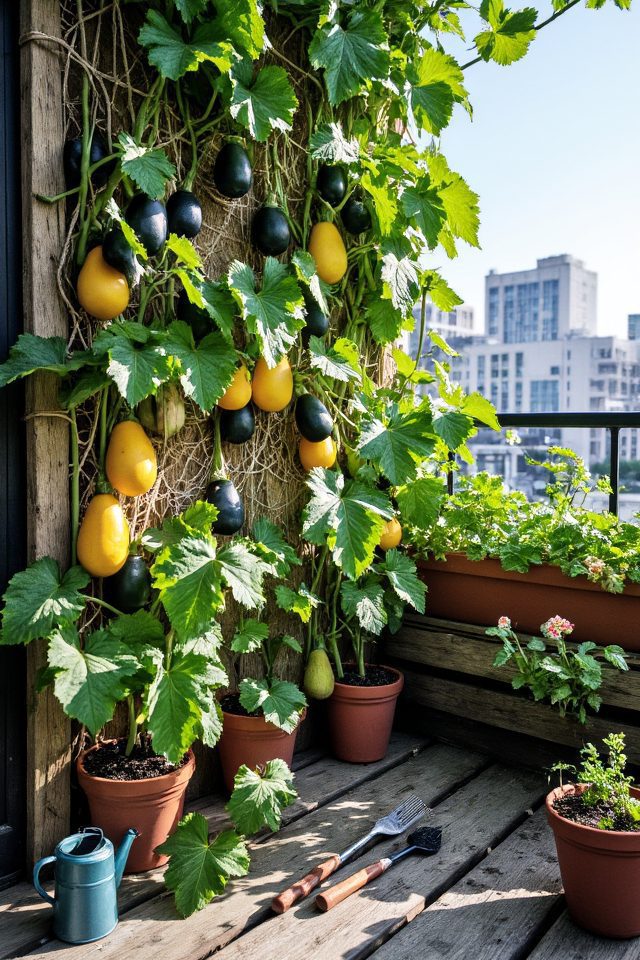
Vertical gardening techniques are perfect for optimizing small spaces when growing squash in a container garden.
By utilizing trellises, wall planters, or hanging planters, you can maximize your growing area while keeping your plants off the ground.
This method not only saves space but also improves air circulation and sunlight exposure for the plants.
Incorporating vertical structures like pipes, ladders, or even poles can create an attractive and functional display, allowing squash vines to thrive in compact environments.
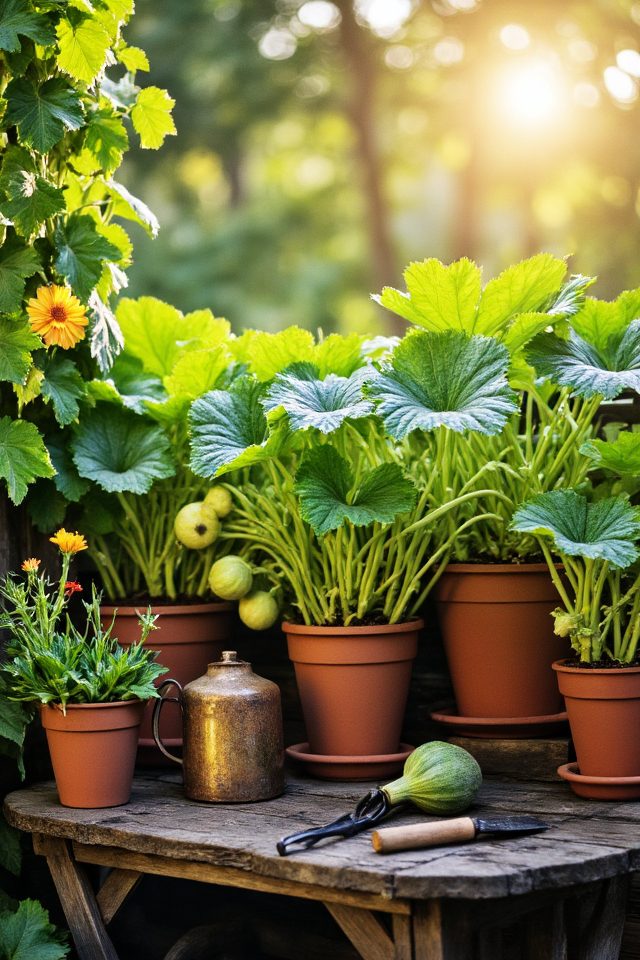
Maximizing sunlight exposure is essential for growing healthy squash in a container garden.
Position your containers where they’ll receive at least six to eight hours of direct sunlight daily. Consider using reflective materials or lighter-colored pots to enhance light exposure.
Additionally, rotating your containers every few days can guarantee that all sides of the plants receive balanced sunlight, promoting even growth and abundant fruit production.
Proper placement and rotation can greatly increase your squash yield.
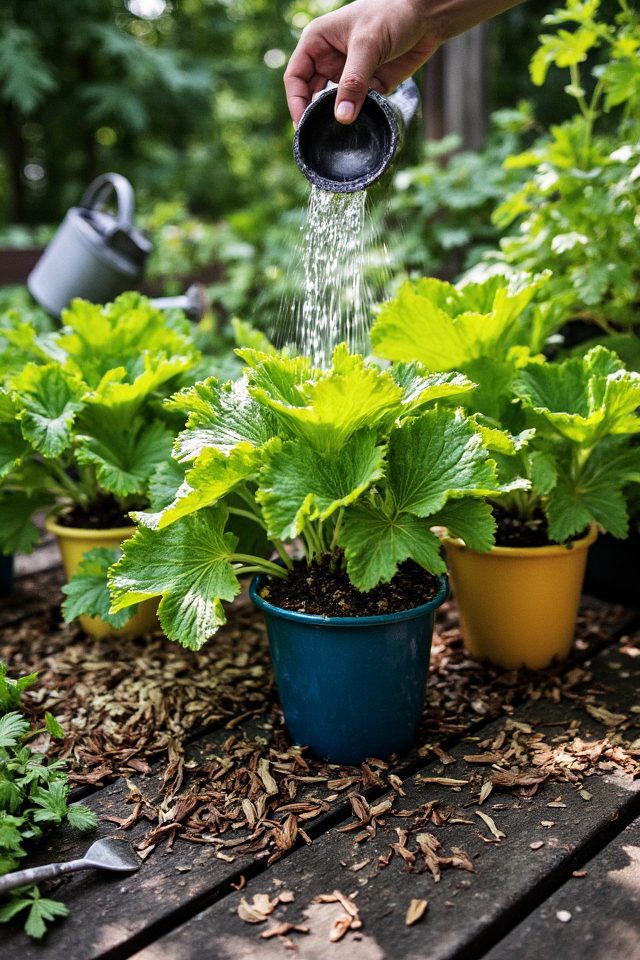
Watering container-grown squash is essential for their growth and productivity. Aim to keep the soil evenly moist but not waterlogged, as squash plants thrive in well-drained conditions.
Check the soil daily, especially during warm weather, as containers dry out faster than garden beds. Water thoroughly until it drains from the bottom, ensuring the roots receive adequate moisture.
Mulching can also help retain soil moisture and reduce evaporation. Adjust your watering schedule based on weather conditions and plant size for ideal results.
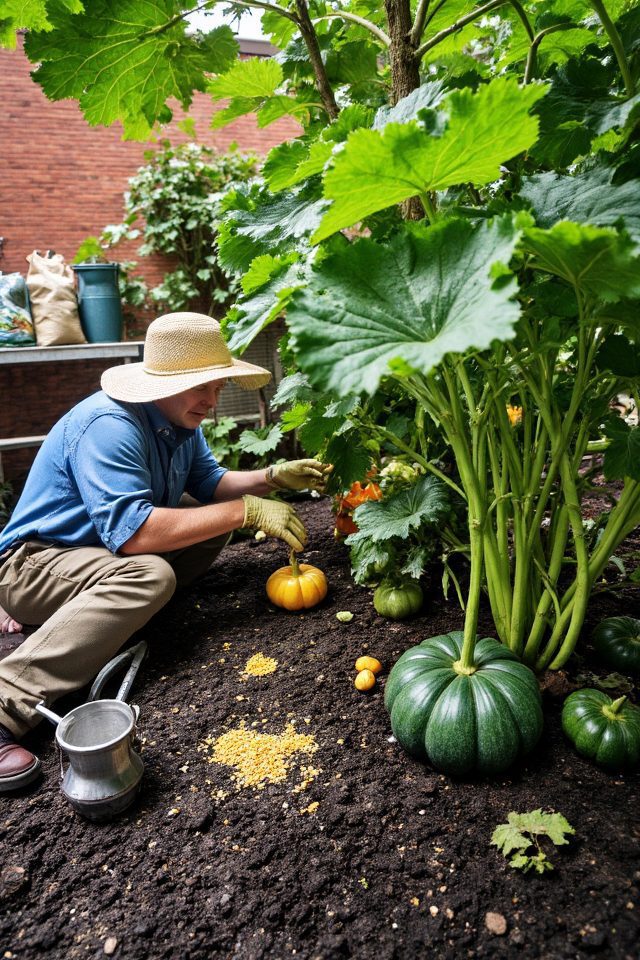
Fertilizing your squash plants effectively is essential for producing healthy, bountiful yields. Start by using a balanced fertilizer that provides essential nutrients like nitrogen, phosphorus, and potassium.
Applying a slow-release formula during planting can help establish strong root systems. Additionally, consider side-dressing with compost or organic fertilizers mid-season to boost growth.
Be mindful not to over-fertilize, as this can lead to excessive foliage growth at the expense of fruit production. Regular soil testing can also guide your fertilization strategy.
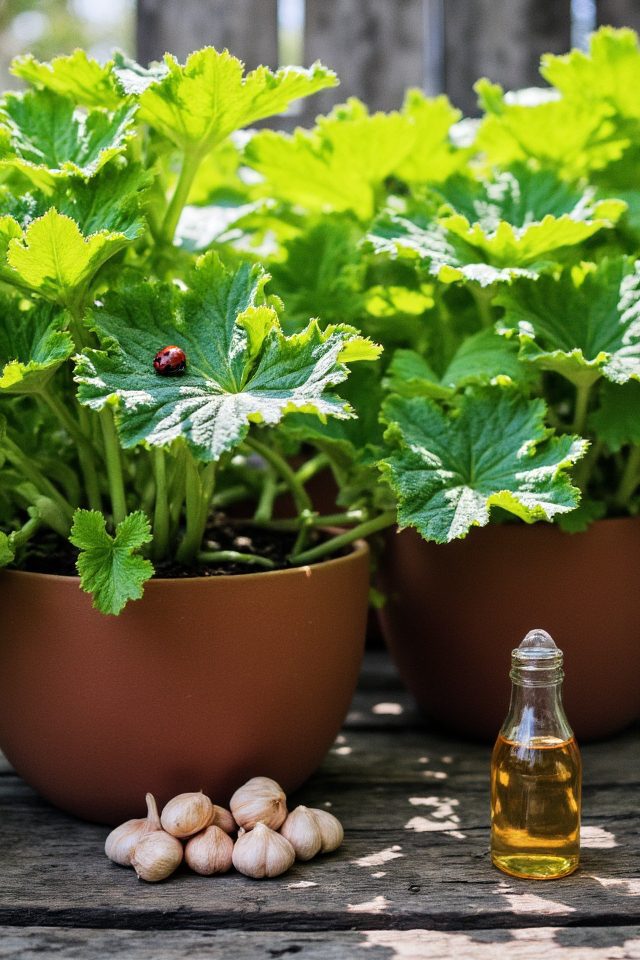
Pest control is essential for maintaining healthy squash plants in container gardens.
Employing natural methods such as introducing beneficial insects like ladybugs and lacewings can effectively reduce pest populations. Additionally, using homemade sprays made from neem oil or garlic can deter common squash pests, including aphids and squash bugs.
Regularly inspecting plants and promoting good air circulation can also mitigate infestations, ensuring robust growth and a bountiful harvest of squash.
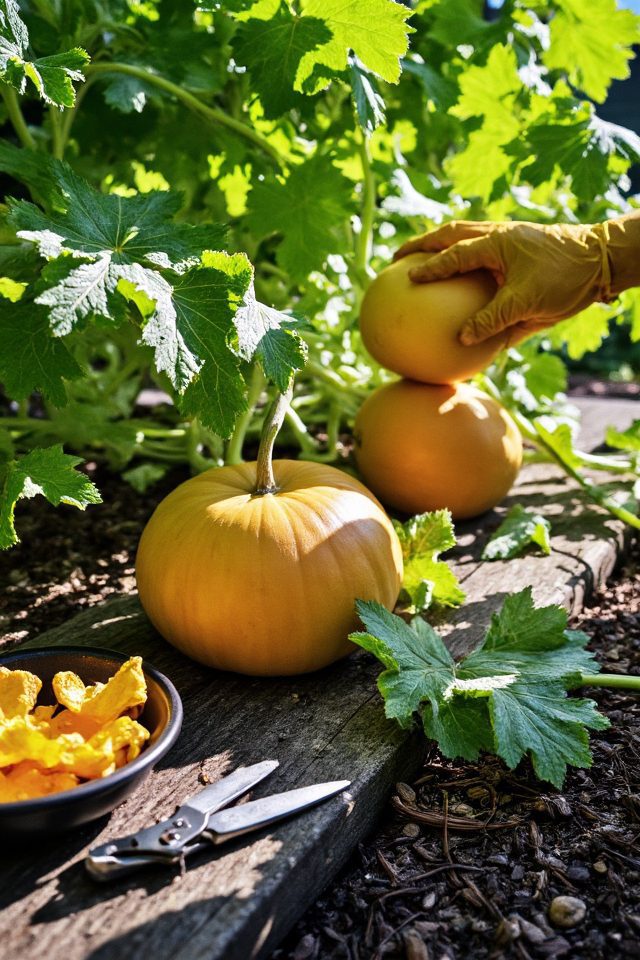
As fall approaches, caring for your squash plants requires specific attention to guarantee a bountiful harvest.
Begin by checking for any signs of pests or diseases, as cooler temperatures can lead to fungal issues. Trim back any dying leaves to enhance airflow around the fruit.
If the temperatures start to drop considerably, consider covering the plants with row fabric to protect them from frost.
Finally, harvest squash before the first hard frost, making sure they’re fully mature for the best flavor and storage.
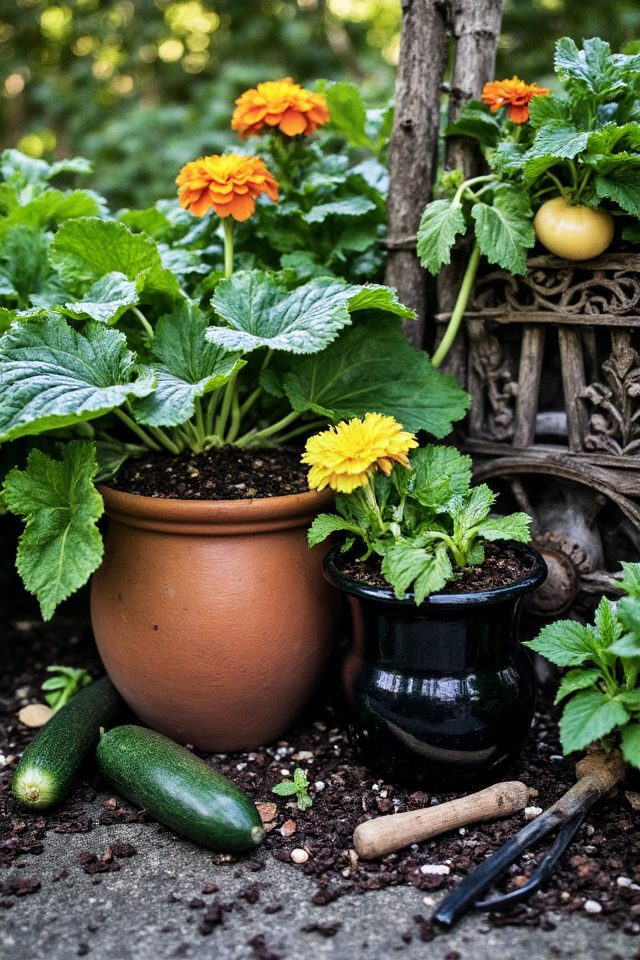
Creative container ideas for squash can add both beauty and functionality to your garden. Use large pots, barrels, or even repurposed items like old wheelbarrows to plant squash varieties like zucchini and butternut.
Vertical gardening structures, such as trellises, can help save space while adding visual interest. Incorporate companion plants like marigolds or basil in the same container to enhance growth and deter pests.
Experiment with different colors and textures for a vibrant container garden!
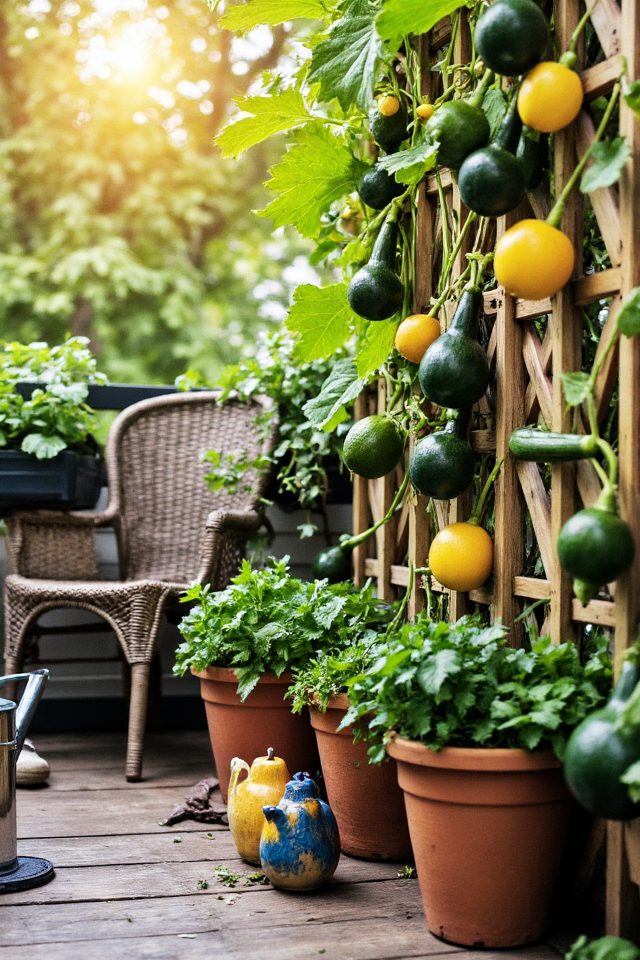
Using trellises in a squash container garden is an excellent way to maximize space and promote healthy growth. By vertically training squash plants, you can keep them off the ground, allowing for better air circulation and reduced risk of disease.
Trellises also free up ground space for additional plants and make harvesting easier. Choose sturdy trellis designs that can support the weight of mature squash, ensuring your container garden remains productive and organized.
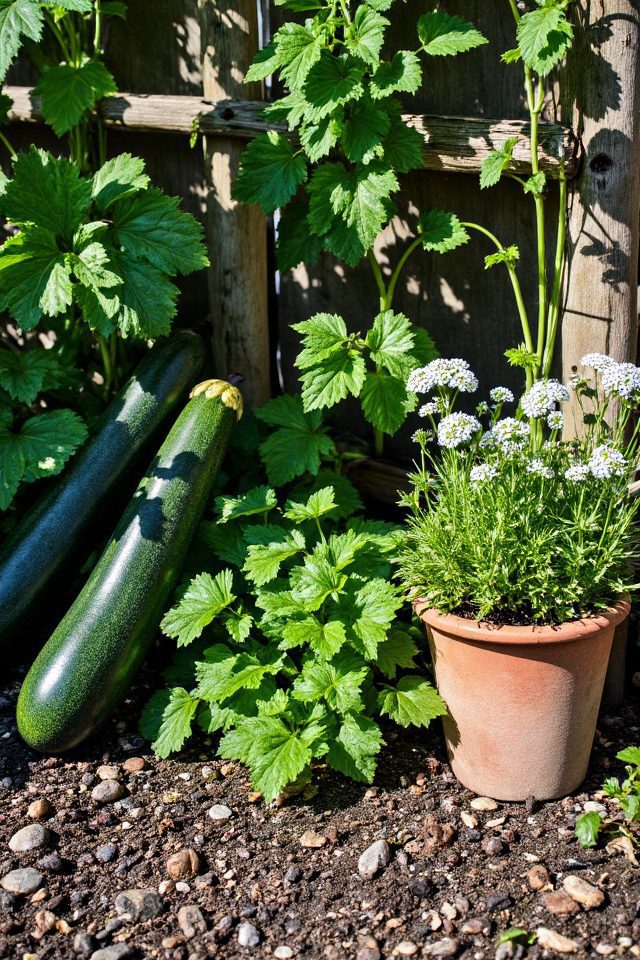
Designing a squash herb garden combines the vibrant growth of squash with the aromatic presence of herbs, creating both a visually appealing and functional space.
Start by selecting a variety of squash, such as zucchini or butternut, and pair them with complementary herbs like basil, dill, or oregano.
Utilize vertical gardening techniques, like trellises, to save space and enhance air circulation.
Guarantee ample sunlight, regular watering, and well-draining soil for a thriving garden that delights the senses.
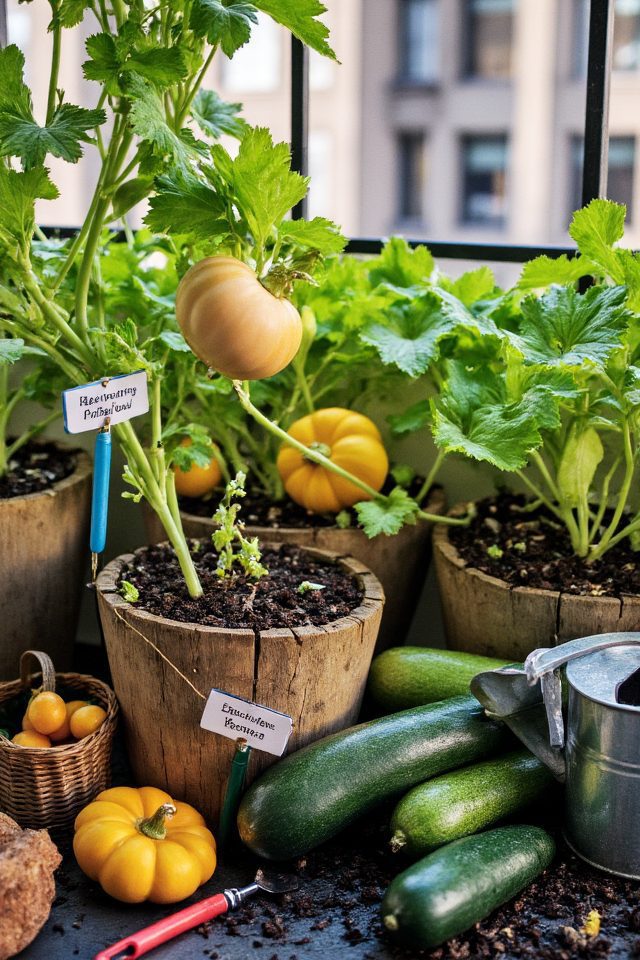
Succession planting is a highly effective technique for ensuring a continuous harvest in your squash container garden.
By staggering the planting of different squash varieties—such as zucchini, butternut, and yellow squash—you can extend your growing season and enjoy fresh produce over several months.
Plant new seeds every few weeks, starting in spring, to replace harvested plants. This not only maximizes space but also promotes a stable supply of fresh squash through the growing season.
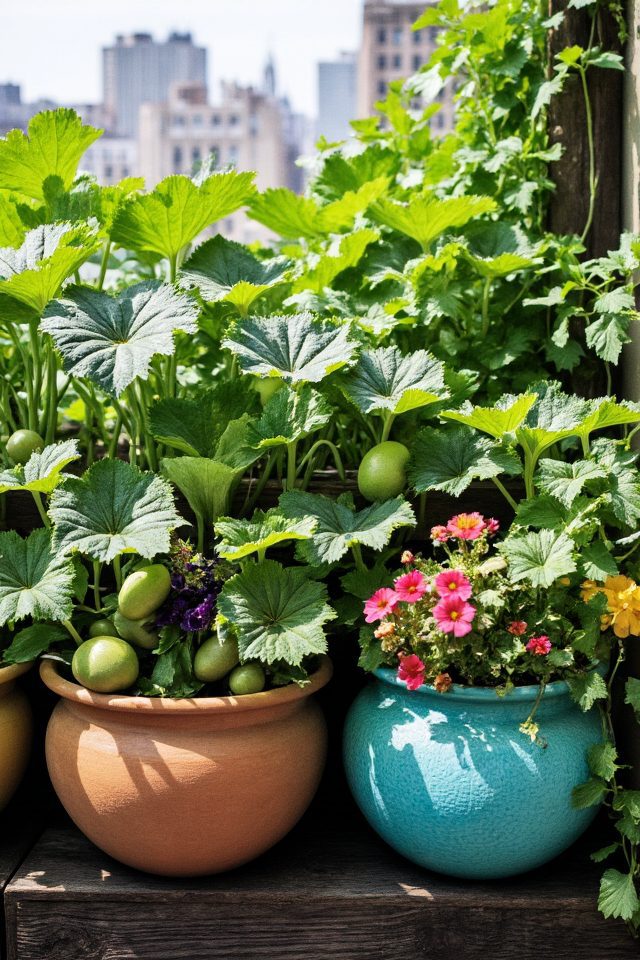
Decorating your space with squash plants can add both beauty and functionality to your garden. These vibrant, sprawling plants not only produce delicious fruits but also create lush green foliage that can enhance any outdoor area.
Using containers allows for versatile arrangements, whether on patios, balconies, or even indoors. Choose colorful pots and pair squash with ornamental plants for a stunning visual effect.
With proper care, your squash container garden will thrive and serve as a unique decor element.
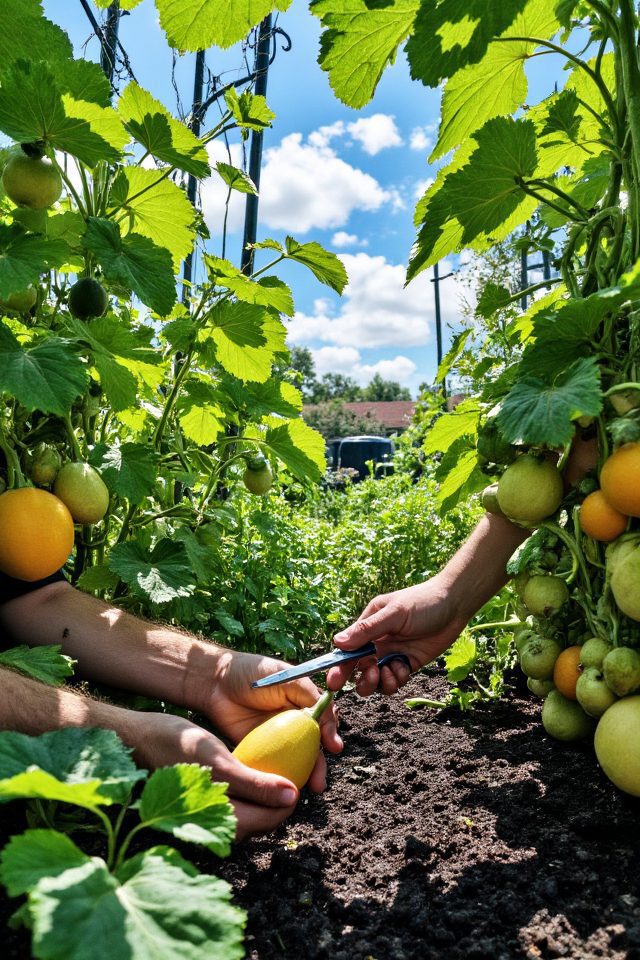
To achieve maximum yield in your squash container garden, timing is key. Harvest squash when they reach their full size but before the skin hardens, typically when they’re bright in color.
Regularly check for pests and diseases, and make certain your plants get adequate water and nutrients. Utilizing a support structure can also improve airflow and light exposure, promoting healthier growth.
Additionally, frequent harvesting encourages the plant to produce more squash throughout the season.
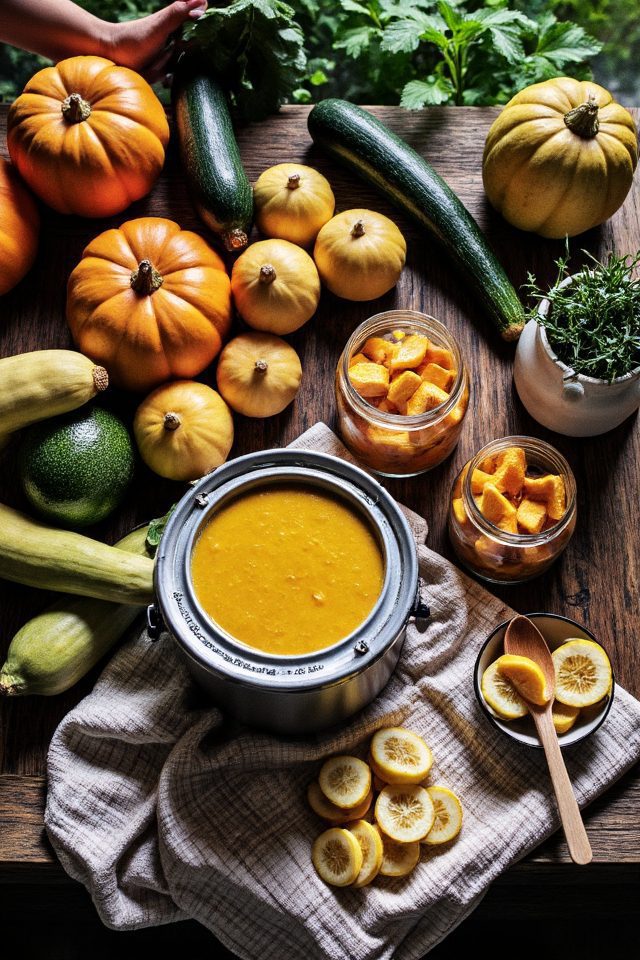
Preserving your squash harvest is essential to enjoy the fruits of your labor throughout the year.
Start by properly curing the squash for a few weeks in a warm, dry place to enhance its flavor and shelf life.
You can also freeze, can, or dehydrate squash to retain its nutrients and taste. Blanching before freezing will help maintain color and texture.
Experiment with recipes like soups or casseroles to make the most of your preserved squash!
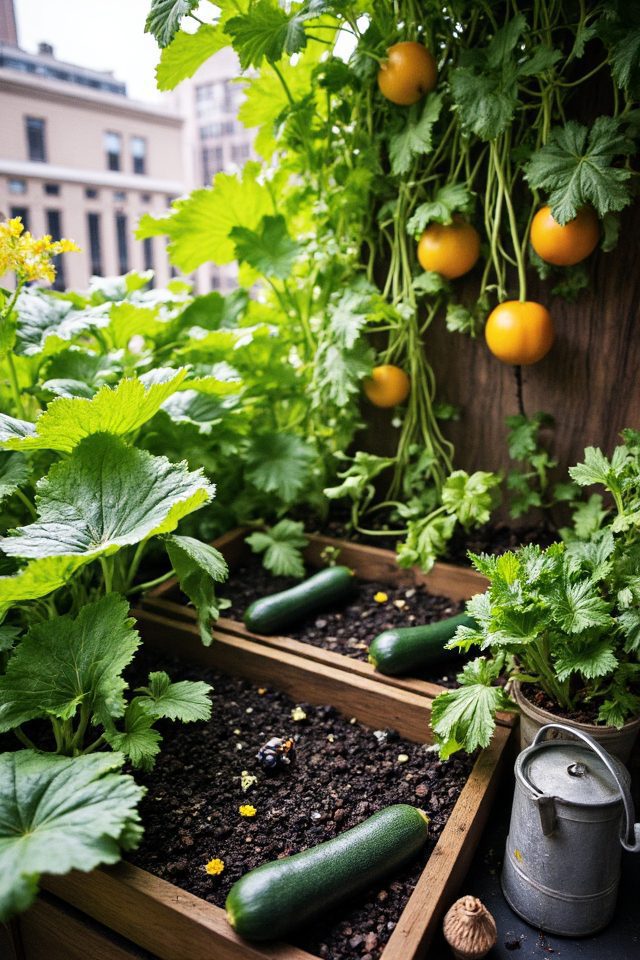
Container squash gardens have transformed urban spaces and small backyards into lush vegetable paradises.
Numerous gardeners have shared their inspiring success stories of growing thriving squash plants in limited spaces.
Many have discovered that with the right potting techniques, quality soil, and consistent care, they can yield bountiful harvests of varieties like zucchini, butternut, and acorn squash.
These stories highlight the joy of gardening, the ease of container use, and the satisfaction of enjoying fresh, homegrown produce.
Incorporating squash into your small space container garden can transform your outdoor area into a vibrant oasis. By choosing the right containers, selecting ideal squash varieties, and using vertical gardening techniques, you’ll maximize your harvest and enhance your space’s beauty. Remember to explore companion planting and soil preparation for healthier plants. With a little care and creativity, you’re well on your way to enjoying a bountiful squash harvest right outside your door! Happy gardening!

Don't let aphids, slugs, and caterpillars ruin another plant. Take back control with simple, natural methods that actually work.